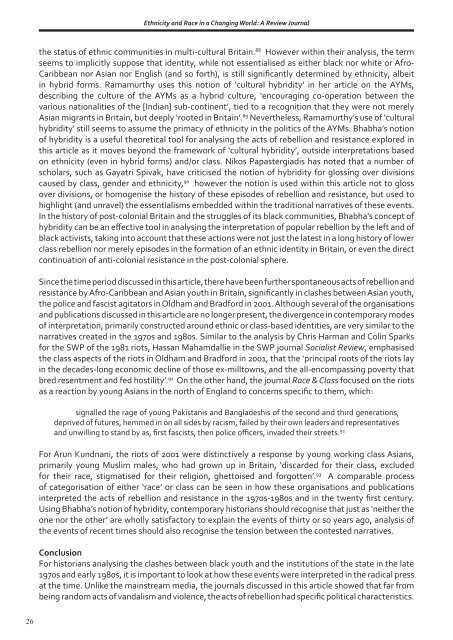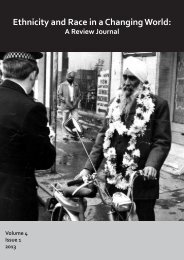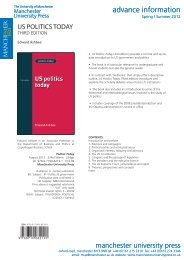Ethnicity and Race in a Changing World
Volume 2, Issue 1, 2010 - Manchester University Press
Volume 2, Issue 1, 2010 - Manchester University Press
- No tags were found...
Create successful ePaper yourself
Turn your PDF publications into a flip-book with our unique Google optimized e-Paper software.
<strong>Ethnicity</strong> <strong>and</strong> <strong>Race</strong> <strong>in</strong> a Chang<strong>in</strong>g <strong>World</strong>: A Review Journalthe status of ethnic communities <strong>in</strong> multi-cultural Brita<strong>in</strong>. 88 However with<strong>in</strong> their analysis, the termseems to implicitly suppose that identity, while not essentialised as either black nor white or Afro-Caribbean nor Asian nor English (<strong>and</strong> so forth), is still significantly determ<strong>in</strong>ed by ethnicity, albeit<strong>in</strong> hybrid forms. Ramamurthy uses this notion of ‘cultural hybridity’ <strong>in</strong> her article on the AYMs,describ<strong>in</strong>g the culture of the AYMs as a hybrid culture, ‘encourag<strong>in</strong>g co-operation between thevarious nationalities of the [Indian] sub-cont<strong>in</strong>ent’, tied to a recognition that they were not merelyAsian migrants <strong>in</strong> Brita<strong>in</strong>, but deeply ‘rooted <strong>in</strong> Brita<strong>in</strong>’. 89 Nevertheless, Ramamurthy’s use of ‘culturalhybridity’ still seems to assume the primacy of ethnicity <strong>in</strong> the politics of the AYMs. Bhabha’s notionof hybridity is a useful theoretical tool for analys<strong>in</strong>g the acts of rebellion <strong>and</strong> resistance explored <strong>in</strong>this article as it moves beyond the framework of ‘cultural hybridity’, outside <strong>in</strong>terpretations basedon ethnicity (even <strong>in</strong> hybrid forms) <strong>and</strong>/or class. Nikos Papastergiadis has noted that a number ofscholars, such as Gayatri Spivak, have criticised the notion of hybridity for gloss<strong>in</strong>g over divisionscaused by class, gender <strong>and</strong> ethnicity, 90 however the notion is used with<strong>in</strong> this article not to glossover divisions, or homogenise the history of these episodes of rebellion <strong>and</strong> resistance, but used tohighlight (<strong>and</strong> unravel) the essentialisms embedded with<strong>in</strong> the traditional narratives of these events.In the history of post-colonial Brita<strong>in</strong> <strong>and</strong> the struggles of its black communities, Bhabha’s concept ofhybridity can be an effective tool <strong>in</strong> analys<strong>in</strong>g the <strong>in</strong>terpretation of popular rebellion by the left <strong>and</strong> ofblack activists, tak<strong>in</strong>g <strong>in</strong>to account that these actions were not just the latest <strong>in</strong> a long history of lowerclass rebellion nor merely episodes <strong>in</strong> the formation of an ethnic identity <strong>in</strong> Brita<strong>in</strong>, or even the directcont<strong>in</strong>uation of anti-colonial resistance <strong>in</strong> the post-colonial sphere.S<strong>in</strong>ce the time period discussed <strong>in</strong> this article, there have been further spontaneous acts of rebellion <strong>and</strong>resistance by Afro-Caribbean <strong>and</strong> Asian youth <strong>in</strong> Brita<strong>in</strong>, significantly <strong>in</strong> clashes between Asian youth,the police <strong>and</strong> fascist agitators <strong>in</strong> Oldham <strong>and</strong> Bradford <strong>in</strong> 2001. Although several of the organisations<strong>and</strong> publications discussed <strong>in</strong> this article are no longer present, the divergence <strong>in</strong> contemporary modesof <strong>in</strong>terpretation, primarily constructed around ethnic or class-based identities, are very similar to thenarratives created <strong>in</strong> the 1970s <strong>and</strong> 1980s. Similar to the analysis by Chris Harman <strong>and</strong> Col<strong>in</strong> Sparksfor the SWP of the 1981 riots, Hassan Mahamdallie <strong>in</strong> the SWP journal Socialist Review, emphasisedthe class aspects of the riots <strong>in</strong> Oldham <strong>and</strong> Bradford <strong>in</strong> 2001, that the ‘pr<strong>in</strong>cipal roots of the riots lay<strong>in</strong> the decades-long economic decl<strong>in</strong>e of those ex-milltowns, <strong>and</strong> the all-encompass<strong>in</strong>g poverty thatbred resentment <strong>and</strong> fed hostility’. 91 On the other h<strong>and</strong>, the journal <strong>Race</strong> & Class focused on the riotsas a reaction by young Asians <strong>in</strong> the north of Engl<strong>and</strong> to concerns specific to them, which:signalled the rage of young Pakistanis <strong>and</strong> Bangladeshis of the second <strong>and</strong> third generations,deprived of futures, hemmed <strong>in</strong> on all sides by racism, failed by their own leaders <strong>and</strong> representatives<strong>and</strong> unwill<strong>in</strong>g to st<strong>and</strong> by as, first fascists, then police officers, <strong>in</strong>vaded their streets. 92For Arun Kundnani, the riots of 2001 were dist<strong>in</strong>ctively a response by young work<strong>in</strong>g class Asians,primarily young Muslim males, who had grown up <strong>in</strong> Brita<strong>in</strong>, ‘discarded for their class, excludedfor their race, stigmatised for their religion, ghettoised <strong>and</strong> forgotten’. 93 A comparable processof categorisation of either ‘race’ or class can be seen <strong>in</strong> how these organisations <strong>and</strong> publications<strong>in</strong>terpreted the acts of rebellion <strong>and</strong> resistance <strong>in</strong> the 1970s-1980s <strong>and</strong> <strong>in</strong> the twenty first century.Us<strong>in</strong>g Bhabha’s notion of hybridity, contemporary historians should recognise that just as ‘neither theone nor the other’ are wholly satisfactory to expla<strong>in</strong> the events of thirty or so years ago, analysis ofthe events of recent times should also recognise the tension between the contested narratives.ConclusionFor historians analys<strong>in</strong>g the clashes between black youth <strong>and</strong> the <strong>in</strong>stitutions of the state <strong>in</strong> the late1970s <strong>and</strong> early 1980s, it is important to look at how these events were <strong>in</strong>terpreted <strong>in</strong> the radical pressat the time. Unlike the ma<strong>in</strong>stream media, the journals discussed <strong>in</strong> this article showed that far frombe<strong>in</strong>g r<strong>and</strong>om acts of v<strong>and</strong>alism <strong>and</strong> violence, the acts of rebellion had specific political characteristics.26






